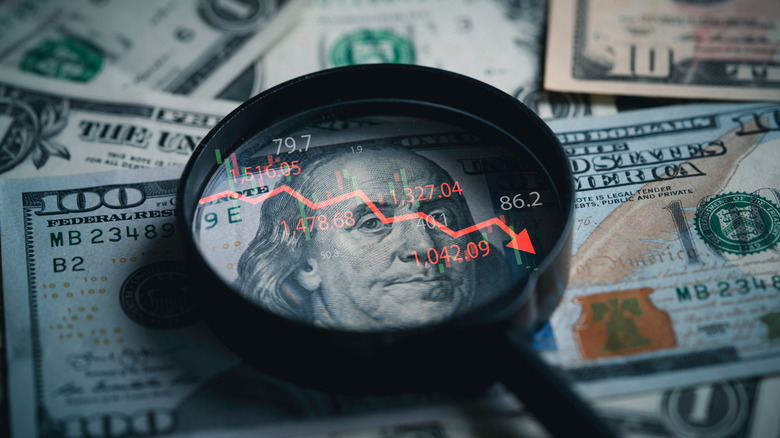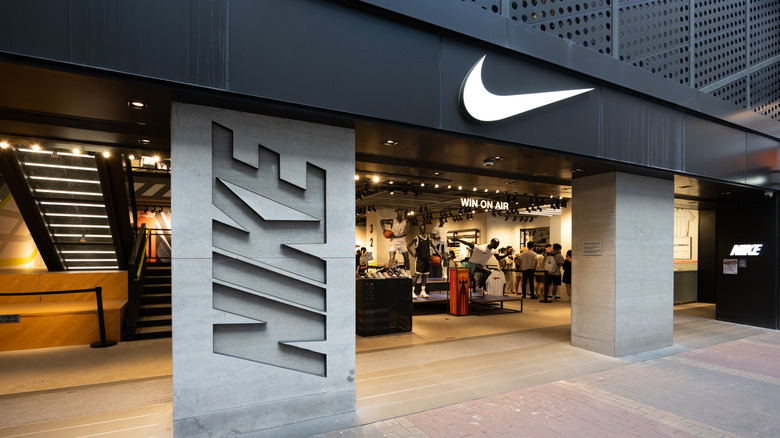Why Experts Are Investing In A Stock Down By More Than 50%
"Hemorrhaging value" isn't typically a pair of words that describe a great investment opportunity. Sure, there's value to be found in a bear market, when stocks across the board are seeing their previous gains erased. But in a stable or bull market, stocks that appear to be shrinking due to their own circumstances frequently don't feature in the plans of investors seeking to make money rather than lose it.
But appearances aren't always what they seem. Take the case of Nike. Since November 2021 the brand has experienced a steady decline in share price, down 60% from its $177 peak. Today, Nike is trading at roughly $75 per share, just a short distance from its 52-week low of $70.32. The institutional trading entity KBC Group NV shed almost 1.7 million shares of Nike in the final quarter of 2024, as well, signaling research that anticipates more potential pain on the horizon. But a stock that's been battered in recent months or years can also represent an interesting value purchase. In the case of Nike, there's plenty to worry over, but still considerable upside to explore. As is the case with really any endeavor in the stock market, there's a twofold path ahead for investors eying the company. It simultaneously holds significant potential and plenty of risk, making it a fascinating case study into why some professional traders are dumping the stock while others gobble it up.
Nike has experienced short term woes but enjoys significant long term upside
There's actually plenty to celebrate about the modern Nike brand from an investment standpoint. Investors like Warren Buffett are consistently chasing after long-term value, and don't tend to take stock in the more mundane movements of day-to-day price changes. Even a lengthy downward spell can provide a possible upshot for value investors like the Oracle of Omaha. In reality, even with a diminishing share value Nike remains a consistent market mover, owning a total market share in its sector of roughly 39%. With such enormous brand power, the company is positioned to remain a preeminent name in the athletic space, regardless of its short term decision making and fiscal performance. And fiscal performance is really what much of this current challenge boils down to. With a shift in focus away from brick and mortar sales and other strategy choices that haven't panned out, the company is experiences sluggish revenue growth. However, growth is still being seen, with total revenue and gross profit figures that have expanded every year since 2021.
The company has also had a change of leadership that will set it up for institutional change. There's no telling whether this will be positive, but a shift in focus is a virtual certainty, allowing the company to begin crafting a new narrative for itself. Since its listing on the New York Stock Exchange in 1985, steady growth has been the norm for Nike. The company has seemingly failed to recover from the setbacks of pandemic-era market factors, but with new management and continuing profit growth, the company looks to be positioning itself for a fresh start.
Value investors are interested in this exact profile
The reasons for experts to take notice of a company like Nike are obvious. Some investors are betting on this being a short term blip, allowing them to buy in at a massive price reduction. Even a trading period lasting a few years can be viewed as a short term phenomenon when considering the bigger picture. For instance, young workers today saving for their retirement will be looking at building a diversified portfolio of assets that will (hopefully) continue growing over the following 30-plus years. A three-year period of downward price action is a sliver of this larger picture. Moreover, if the stock does turn itself around and rise back up to its pre-pandemic pricing levels, buying in today allows for a huge run of growth before the conversation even focuses on where the company will be heading after righting itself.
This isn't to say that Nike should be a buy for all investors, but numerous outlets do offer buy or hold calls for the stock (Zacks, on the other hand labels Nike a "strong sell"). Bringing in a longtime Nike veteran in Elliott Hill to run the company bodes well for its future, given his decades of experience in developing winning solutions within the company's existing product lineup, culture, and marketing language. However, fiscal data does suggest that Nike is spending notably more of its cash to run operations today than in previous years, highlighting a potential sore spot for stock growth. With all this in mind, Nike closely fits the mold of a brand deeply undervalued for its market position, and long term investors frequently seek to shore up a position in companies like this ahead of potentially forceful upward pricing movement.
Risk remains ahead, however
Investing in a company like Nike isn't without its risks, though. Beginners in the stock market will want to carefully weigh up their options when considering parking some of their cash in Nike or any other brand experiencing similar downward pricing momentum. Risk tolerance is a crucial thing to explore as you take your first steps into the market. A company that has seen a long-running and consistent tumble in price may simply be resetting to a new normal. It's entirely possible that Nike's long-running price appreciation wasn't a natural growth but rather a bubble that has now popped. This would leave Nike's current pricing as a more appropriate level for its value in the market. There's really no way to be entirely sure about where the company's share price will go heading into the future.
Risk is an inherent feature of stock trading, and it's completely possible that an investment in a company like Nike today will yield continued losses rather than growth. Analysis of the company and its position in the market as a whole suggests that it's at least partially undervalued in the present, but all manner of external factors play a role in any given company's pricing movements. Investors will want to do their own research into a company's history, financials, and projected future movements before deciding to buy. Following others into the market won't always get the job done, and in the case of Nike, it's hard to determine from a surface level view which set of expert investors have it right.



